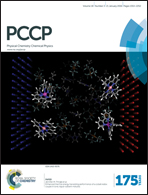Insights into structural and dynamical features of water at halloysite interfaces probed by DFT and classical molecular dynamics simulations†
Abstract
Density functional theory calculations and classical molecular dynamics simulations have been used to investigate the structure and dynamics of water molecules on kaolinite surfaces and confined in the interlayer of a halloysite model of nanometric dimension. The first technique allowed us to accurately describe the structure of the tetrahedral–octahedral slab of kaolinite in vacuum and in interaction with water molecules and to assess the performance of two widely employed empirical force fields to model water/clay interfaces. Classical molecular dynamics simulations were used to study the hydrogen bond network structure and dynamics of water adsorbed on kaolinite surfaces and confined in the halloysite interlayer. The results are in nice agreement with the few experimental data available in the literature, showing a pronounced ordering and reduced mobility of water molecules at the hydrophilic octahedral surfaces of kaolinite and confined in the halloysite interlayer, with respect to water interacting with the hydrophobic tetrahedral surfaces and in the bulk. Finally, this investigation provides new atomistic insights into the structural and dynamical properties of water–clay interfaces, which are of fundamental importance for both natural processes and industrial applications.


 Please wait while we load your content...
Please wait while we load your content...